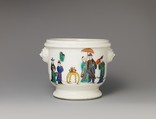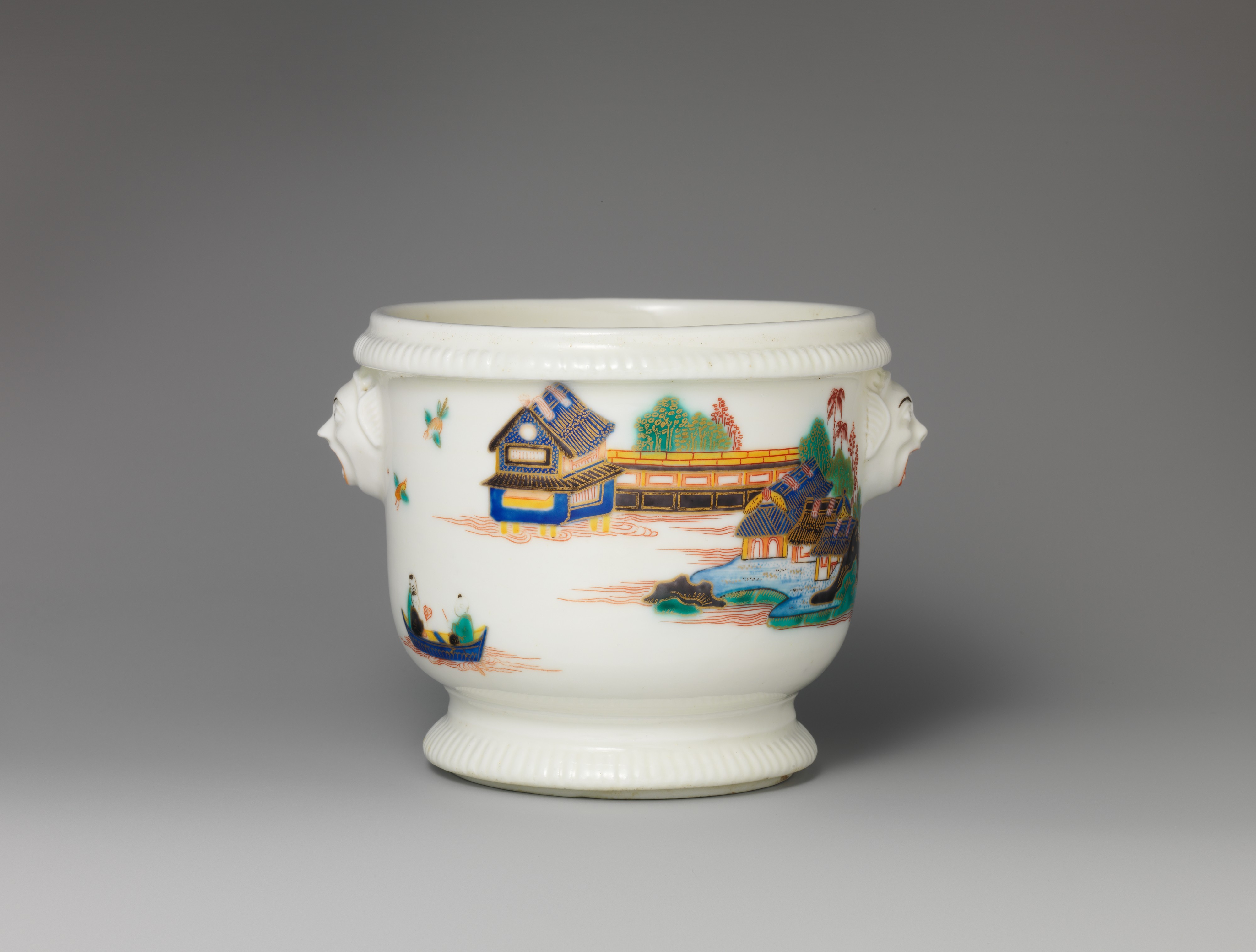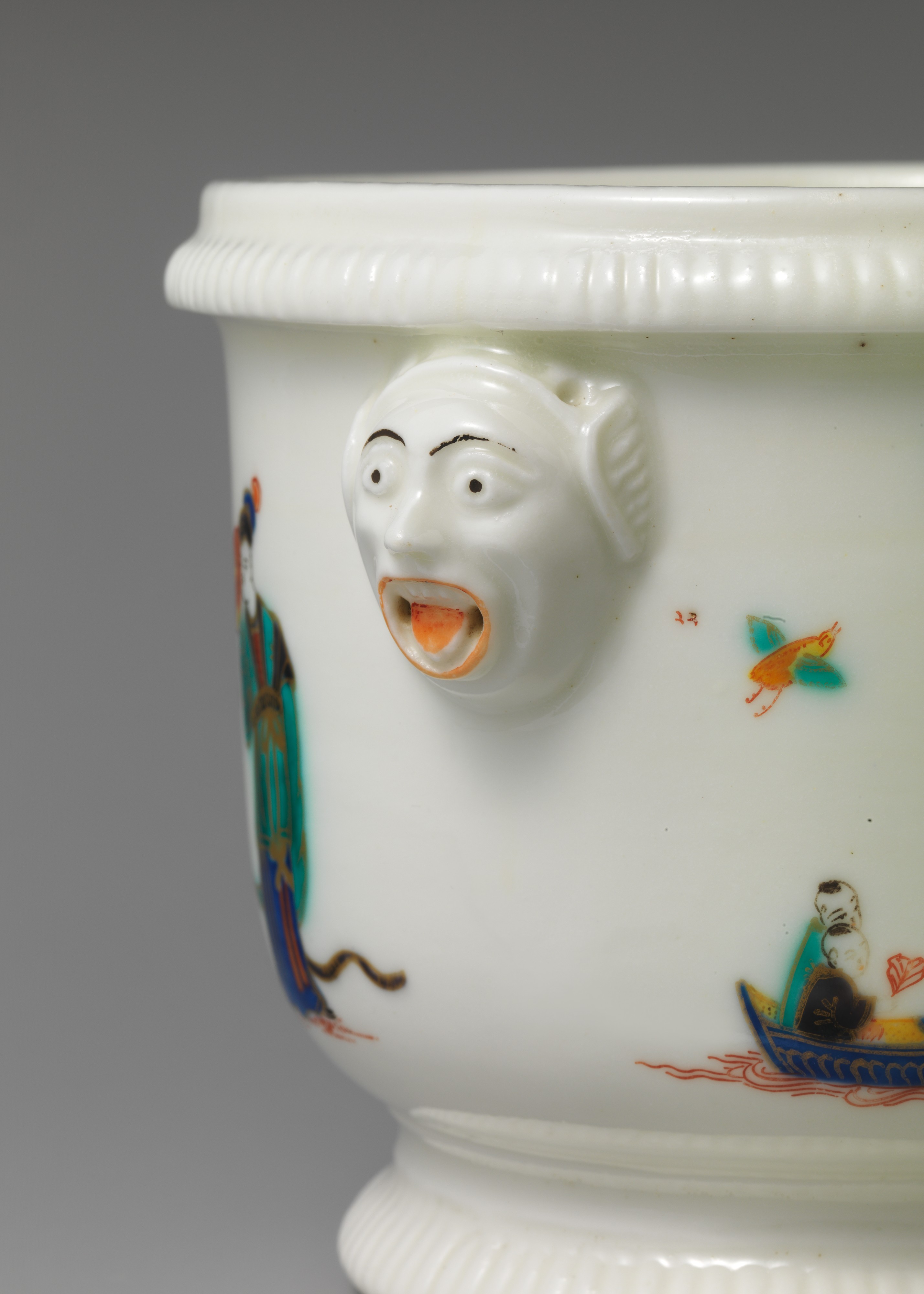Glass cooler (seau à verre)
Factory Saint-Cloud factory French
Not on view
It is believed that the Saint-Cloud factory began using enamel colors in the 1720s, and the palette of five colors developed at the factory at this time allowed for a different style of decoration than what had been employed for porcelains painted solely with cobalt blue. For those pieces to be decorated with colored enamels, the painters at Saint-Cloud almost always took their inspiration from Chinese and Japanese art. They sometimes borrowed motifs directly from imported porcelains and lacquer work, but more frequently painters devised images and patterns intended to evoke Far Eastern culture, or combined borrowed motifs in a distinctly European manner. It is probable that the factory painters had access to Chinese and Japanese porcelains either through the collection of Philippe II (1674–1723), duc d’Orléans, who granted protection to the factory in 1702, or through the owners of the factory who sold imported porcelains in their capacity as marchands faienciers, or dealers in ceramics. Despite the availability of these works, there was little attempt to faithfully copy either Chinese or Japanese models. Motifs from imported porcelains were sometimes combined on the same object, and there was little consistent adherence to the color scheme of the source of the original motif. Most notably, imagery inspired by these models, or intended to suggest an imagined Far East, was employed by the factory on European forms almost exclusively. The factory’s production focused on functional objects, most of which were intended for use on the dining table, as part of a toilet service, or for the consumption of tea, and it is on these objects that Chinese or Japanese imagery is commonly found rather than on decorative vases derived from Far Eastern forms.
This glass cooler is decorated with unusually ambitious Far Eastern–inspired compositions of figures standing around a table and a landscape consisting of pavilions at the edge of the water with two figures rowing a boat. It has been suggested that the landscape recalls those found on Chinese lacquer.[1] The cooler is painted in the typical Saint-Cloud palette of a turquoise green, blue, purplish-brown, yellow, red, and black. Gilding has been used subtly but extensively to provide details in the robes of the figures, the fans, and throughout the landscape. This prominent role of gilding in defining the elements of the composition and the use of red enamel to provide additional detail reflects a very specific style of decoration at Saint-Cloud that seems to have been employed only on glass coolers and cream pots, for reasons that are not immediately apparent.[2] The enamels used at Saint Cloud were translucent due to the low level of mineral oxides in their composition,[3] and this translucency made them especially suitable for Chinese-inspired motifs, recalling the colors found on Chinese famille verte porcelains (see 54.147.81; 1974.356.363; 64.142. 32–.34) in particular.[4] This translucency is especially apparent in the turquoise green used for the robes of three of the figures and in elements of the landscape. However, the translucent nature of some of the Saint-Cloud colors made them less appropriate for European subject matter as the lack of opacity made shading impossible, thus preventing the suggestion of depth and perspective that was central to Western compositions.
The scenes of figures around a table and a landscape with pavilions, which decorate the present example, are found on other Saint-Cloud glass coolers of the same model, and the very close similarity of the compositions on all of the examples suggests that a stencil for pouncing was employed. There are other instances when a stencil appears to have been used for a certain composition created at Saint-Cloud,[5] and the close correspondence of images on certain pieces of Saint-Cloud porcelain and on some of the faience made in the northern French town of Sinceny, to which at least one Saint-Cloud worker is known to have moved,[6] supports the hypothesis that pouncing was practiced with some frequency. Interestingly, the palette of five colors seems to have been employed identically for each of the compositions,[7] which suggests that a colored print or other source was available to the painters at the factory.
It is likely that both glass coolers and bottle coolers were produced in sets at the Saint-Cloud factory, but little is known about the numbers of coolers typically found in a set, and it is not clear what number of objects composed a typical set. Madame de Pompadour’s (1721–1764) after-death inventory lists a substantial number of Saint-Cloud coolers: twenty- eight bottle coolers with relief decoration, four liqueur-bottle coolers, and forty-two glass coolers were recorded among her possessions at the Château de Compiègne,[8] and twenty-six similar bottle coolers and thirty-two glass coolers were listed at the Château de Fontainebleau.[9] At least fourteen other glass coolers with decoration matching the present example are known,[10] but it is not clear if these were produced as part of one large set or in smaller groupings.
From surviving examples, it is evident that the Saint-Cloud factory produced bottle and glass coolers in sizable quantities, though most are not painted in enamels but rather are left white and have low-relief decoration consisting of stylized vegetation (see 54.147.13).[11] Smaller in scale than bottle coolers, glass coolers such as this example allowed the base of the glass to rest on the rim of the cooler, permitting the bowl of the glass to be either chilled or rinsed in the icy water. Glass coolers were placed on the table within reach of the diner, a custom increasingly favored in the second half of the eighteenth century when a less-formal dining etiquette prevailed, and the role of the servant diminished as more intimate dinners became popular.
Footnotes
(For key to shortened references see bibliography in Munger, European Porcelain in the Metropolitan Museum of Art. NY: The Metropolitan Museum of Art, 2018)
1 Bertrand Rondot in Rondot 1999a, p. 285.
2 Ibid.
3 Rondot in ibid., p. 284.
4 For more information on famille verte, see Jörg 2011, pp. 9–11.
5 Rondot in Rondot 1999a, p. 280.
6 Rondot in ibid., p. 281.
7 This is true in regard to all of those examples that have been reproduced in color, but one pair is illustrated only in black and white (Christie’s, London, sale cat., October 28, 1963, no. 105). Saint- Cloud glass coolers with the same decorative scheme, including the same use of polychrome, are a pair in the Cleveland Museum of Art (1944.226.1, .2); a pair in the Museum of Fine Arts, Boston (Vivian S. Hawes in Hawes and Corsiglia 1984, pp. 158–61, no. 52); a pair in the Museo Duca di Martina, Naples (Casanova 1974, p. 69, no. 4); one at Christie’s, London, sale cat., June 12, 1995, no. 372; a pair at Drouot- Richelieu, Paris, sale cat., June 14, 2005, no. 178; and a pair at Sotheby Parke Bernet, New York, sale cat., December 3, 1975, no. 233.
8 Cordey 1939, p. 131, no. 1714.
9 Ibid., p. 134, nos. 1758, 1759.
10 In addition to the coolers listed in note 7 above, a single cooler was in the collection of the comte de Chavagnac; see Hôtel Drouot 1911, no. 82. The close similarity of the painted decoration on all of these coolers makes it difficult to determine if the Chavagnac cooler is one of those sold in subsequent sales or if, indeed, the count of fifteen known coolers (including the Museum’s single example) is accurate. In addition, a wine-bottle cooler with similar painted decoration has been identified as the one owned by Chavagnac (Sotheby Parke Bernet, New York, sale cat., December 3, 1975, no. 232), but its larger size and different handles indicate that it was not the one sold by Chavagnac and, in fact, belongs to a different group.
11 See Clare Le Corbeiller in Roth and Le Corbeiller 2000, p. 23, no. 5.
Due to rights restrictions, this image cannot be enlarged, viewed at full screen, or downloaded.
This artwork is meant to be viewed from right to left. Scroll left to view more.





